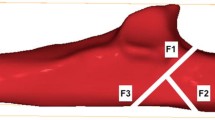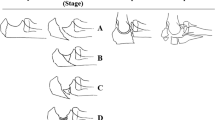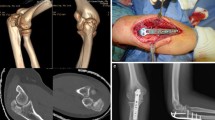Abstract
Purpose
The complication rate of a tension band wiring (TBW) used for the internal fixation of olecranon fractures remains high. The aim of this study was to compare the stability of a novel olecranon tension plate (OTP) with TBW in a simulated fracture model.
Methods
We tested 12 fresh frozen-pairs of cadaver proximal ulnae treated with OTP and TBW under cyclic loading. The elbow motion ranged from full extension to 90° of flexion, and the pulling force of the triceps tendon ranged from 50 to 350 N. The displacement of the fracture fragments was measured continuously. Data were assessed statistically using the Wilcoxon test with significance level of p < 0.05.
Results
The cyclic loading tests showed median displacements of the fracture fragments of 0.25 mm using OTP and 1.12 mm for TBW. Statistical analysis showed the difference to be substantial (p = 0.086) but not statistically significant. No plate breakage or screw loosening occurred.
Conclusions
The concept of replacing prominent K-wires at the proximal end of the ulna using an low-profile plate with classical lag and multidirectional angle-stable screws demonstrated biomechanical advantages over TBW.





Similar content being viewed by others
References
Karlsson MK, Hasserius R, Karlsson C et al (2002) Fractures of the olecranon: a 15- to 25-year followup of 73 patients. Clin Orthop Relat Res 403:205–212. doi:10.1097/01.blo.0000022181.66847.50
Veillette CJH, Steinmann SP (2008) Olecranon fractures. Orthop Clin N Am 39:229–236. doi:10.1016/j.ocl.2008.01.002, vii
Rommens PM, Küchle R, Schneider RU, Reuter M (2004) Olecranon fractures in adults: factors influencing outcome. Injury 35:1149–1157. doi:10.1016/j.injury.2003.12.002
Newman SDS, Mauffrey C, Krikler S (2009) Olecranon fractures. Injury 40:575–581. doi:10.1016/j.injury.2008.12.013
Wiegand L, Bernstein J, Ahn J (2012) Fractures in brief: olecranon fractures. Clin Orthop Relat Res 470:3637–3641. doi:10.1007/s11999-012-2393-5
Edwards SG, Cohen MS, Lattanza LL et al (2012) Surgeon perceptions and patient outcomes regarding proximal ulna fixation: a multicenter experience. J Shoulder Elb Surg 21:1637-1643. doi:10.1016/j.jse.2011.11.024
Mullett JH, Shannon F, Noel J et al (2000) K-wire position in tension band wiring of the olecranon—a comparison of two techniques. Injury 31:427–431
Schneider MM, Nowak TE, Bastian L et al (2014) Tension band wiring in olecranon fractures: the myth of technical simplicity and osteosynthetical perfection. Int Orthop 38:847–855. doi:10.1007/s00264-013-2208-7
Catalano LW, Crivello K, Lafer MP et al (2011) Potential dangers of tension band wiring of olecranon fractures: an anatomic study. J Hand Surg Am 36:1659–1662. doi:10.1016/j.jhsa.2011.07.001
Candal-Couto JJ, Williams JR, Sanderson PL (2005) Impaired forearm rotation after tension-band-wiring fixation of olecranon fractures: evaluation of the transcortical K-wire technique. J Orthop Trauma 19:480–482
Todisco M, Trisi P (2005) Bone mineral density and bone histomorphometry are statistically related. Int J Oral Maxillofac Implants 20:898–904
Labitzke R (1975) The lateral tension band. Demonstrated for fractures of the olecranon (author’s transl). Arch Orthop Unfallchir 81:193–198
Nowak TE, Burkhart KJ, Andres T et al (2013) Locking-plate osteosynthesis versus intramedullary nailing for fixation of olecranon fractures: a biomechanical study. Int Orthop 37:899–903. doi:10.1007/s00264-013-1854-0
Nowak TE, Burkhart KJ, Mueller LP et al (2010) New intramedullary locking nail for olecranon fracture fixation—an in vitro biomechanical comparison with tension band wiring. J Trauma 69:E56–E61. doi:10.1097/TA.0b013e3181c9af9b
Hutchinson DT, Horwitz DS, Ha G et al (2003) Cyclic loading of olecranon fracture fixation constructs. J Bone Joint Surg Am 85-A:831–837
Brink PRG, Windolf M, de Boer P et al (2012) Tension band wiring of the olecranon: is it really a dynamic principle of osteosynthesis? Injury. doi:10.1016/j.injury.2012.08.052
Wilson J, Bajwa A, Kamath V, Rangan A (2011) Biomechanical comparison of interfragmentary compression in transverse fractures of the olecranon. J Bone Joint Surg (Br) 93:245–250. doi:10.1302/0301-620X.93B2.24613
Bailey CS, MacDermid J, Patterson SD, King GJ (2001) Outcome of plate fixation of olecranon fractures. J Orthop Trauma 15:542–548
Hume MC, Wiss DA (1992) Olecranon fractures. A clinical and radiographic comparison of tension band wiring and plate fixation. Clin Orthop Relat Res 285:229–235
Kozin SH, Berglund LJ, Cooney WP et al (1996) Biomechanical analysis of tension band fixation for olecranon fracture treatment. J Shoulder Elb Surg 5:442–448
Chen X, Liu P, Zhu X et al (2013) Design and application of nickel-titanium olecranon memory connector in treatment of olecranon fractures: a prospective randomized controlled trial. Int Orthop 37:1099–1105. doi:10.1007/s00264-013-1878-5
Buijze GA, Blankevoort L, Tuijthof GJM et al (2010) Biomechanical evaluation of fixation of comminuted olecranon fractures: one-third tubular versus locking compression plating. Arch Orthop Trauma Surg 130:459–464. doi:10.1007/s00402-009-0980-z
Prayson MJ, Williams JL, Marshall MP et al (1997) Biomechanical comparison of fixation methods in transverse olecranon fractures: a cadaveric study. J Orthop Trauma 11:565–572
Snoddy MC, Lang MF, An TJ et al (2014) Olecranon fractures: factors influencing re-operation. Int Orthop 38:1711–1716. doi:10.1007/s00264-014-2378-y
Duckworth AD, Clement ND, Aitken SA et al (2012) The epidemiology of fractures of the proximal ulna. Injury 43:343–346. doi:10.1016/j.injury.2011.10.017
Acknowledgments
No benefits in any form have been or will be received from a commercial party related directly or indirectly to the subject of this study by any of the authors.
The biomechanical laboratory of the Department of Trauma Surgery is supported by a yearly grants from Medartis AG, Basel, Switzerland.
Author information
Authors and Affiliations
Corresponding author
Rights and permissions
About this article
Cite this article
Gruszka, D., Arand, C., Nowak, T. et al. Olecranon tension plating or olecranon tension band wiring? A comparative biomechanical study. International Orthopaedics (SICOT) 39, 955–960 (2015). https://doi.org/10.1007/s00264-015-2703-0
Received:
Accepted:
Published:
Issue Date:
DOI: https://doi.org/10.1007/s00264-015-2703-0




